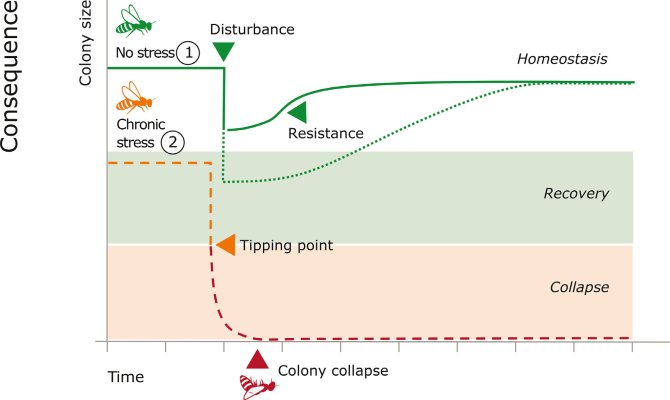
News
Understanding social resilience essential to honeybee health
Why do some honeybee colonies collapse from environmental changes and stressor such as parasites, food deficiency, and diseases, while others can recover? The capacity for honeybee colonies, to maintain homeostasis and/or return back to homeostasis in the face of stressors is defined as social resilience. Measuring social resilience is a novel approach for managing honeybee health and may help with future loss prevention and sustainable beekeeping.
The recently published article, “Understanding social resilience in honeybee colonies” in the open-access journal Current Research in Insect Science discusses what mechanisms colonies use to recover back to and/or maintain stability after stress exposure. The authors, amongst whom bijen@wur researchers Zeynep Ülgezen and Dr. Coby van Dooremalen, examine social resilience in honeybees as a mechanism to cope with stress, identify what methods honeybees use for it, and discuss how resilience can be measured.
In past decades, honeybee colonies have been experiencing high losses, caused by several stressors such as varroa, climate change, and pesticides. Previous experiments. show that these stressors have an effect both on individual bees and on colony level. Although individuals can die, colonies do not always collapse from stressors.
Superorganisms with social resilience
As a superorganism, the colony can maintain or return back to homeostasis through colony mechanisms. Honeybees are described as superorganisms. This means that they are a group of individuals that act as a whole. The self-regulatory behaviours of individual bees and interactions among nestmates maintain the colony in a balanced state. As a superorganism, the colony can maintain or return back to homeostasis after stress exposure through colony mechanisms. This capacity is defined as social resilience.
Chronic stress
Social resilience in honeybees can become compromised due to chronic stress. For instance, in colonies with Varroa infestation. When stress is sustained for too long, colony may not be able to maintain or recover back to homeostasis, which can lead to the depletion of resilience. As the colony becomes less resilient in may be more vulnerable to additional stress or environmental changes. Healthy colonies may show resistance to maintain homeostasis or recover back to homeostasis after stressor exposure. Colonies under chronic stress are more vulnerable to the effects of the disturbance, they can be pushed past the tipping point and may be unable to recover and eventually collapse.

Coping mechanisms
Therefore, the authors suggest that measuring social resilience in colonies may be beneficial for honeybee health. However, they state that before it can be measured, mechanisms of resilience need to be understood.
In this article the authors identify three coping mechanisms for social resilience based on honeybee ecology.
- Thermoregulation in winter for survival in cold temperatures, where colonies form a thermoregulatory cluster to inhibit heat loss.
- Timing of brood rearing and nest emergence in spring, for coping with changes in environmental factors and colony resources.
- ) Division of labour in spring and summer, where honeybees in colonies perform different tasks for growth, reproduction and preparation for winter.
Social resilience as a mechanism for coping with stress
The effect of stress on these coping mechanisms and how shifts and loss of resilience may occur in response are further discussed in the article: "Understanding social resilience in honeybee colonies". This article appeared in the free journal 'Current Research in Insect Science' and discusses the mechanisms used by colonies to recover and/or maintain stability after exposure to stress. The authors, who include Bee@WUR researchers Zeynep Ülgezen and Dr Coby van Dooremalen, examine social resilience in honeybees as a mechanism for coping with stress, identify the methods honeybees use to do so and discuss how resilience can be measured. The researchers stress that understanding social resilience, and through it identifying indicators of loss of resilience is essential to honeybee health and loss prevention.